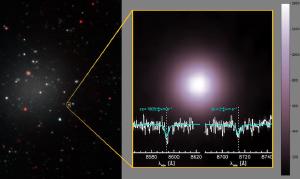Blog
Out of the Dark
30 March 2018
 Gemini Observatory/NSF/AURA/Keck/Jen Miller/Joy Pollard
Gemini Observatory/NSF/AURA/Keck/Jen Miller/Joy PollardDark matter is the mystery that holds the universe together. Although it can’t be seen directly, we know it is there through its gravitational effect on light and the motion of matter. Dark matter makes up most of a galaxy’s mass, and there are some galaxies that are almost entirely dark matter. This makes sense, because the atoms and molecules of stars and dust comprise only 12% of the mass in the universe. In the standard cosmological model, clumps of dark matter triggered the formation of galaxies and galactic clusters in the early universe, where there are galaxies there is dark matter. But recently astronomers have found a galaxy with almost no dark matter, and it’s raising questions about how it could have formed.
The galaxy in question is an ultradiffuse galaxy. These are galaxies that can be as big as our Milky Way, but contain only a few billion stars, rather than the 400 billion of our home galaxy. Because they are diffuse and faint we have only recently been able to study them. Most of these ultradiffuse galaxies contain dark matter, but this new galaxy is different.
The amount of dark matter in a galaxy can be estimated by studying the motion of globular clusters in a galaxy. These are tight clusters of stars that are scattered around a galaxy like a halo. The more mass a galaxy has, the faster these clusters move as they orbit the galaxy. By comparing the speed of globular clusters with the brightness of stars in a galaxy, we can compare the visible mass of a galaxy to its total mass. When the team did this for the new galaxy, they found the motion of its globular clusters agreed with the visible mass of stars and dust. No dark matter is needed to make up the difference.
The existence of a galaxy free from dark matter further confirms that dark matter is both real and different from regular matter. If dark matter were an illusion due to modified gravity then such a galaxy couldn’t exist. Dark matter is out there, just not in this particular galaxy. But if that’s true, then how could this galaxy have formed. One idea is that the galaxy could have been involved in a collision with another galaxy, which stripped away its dark matter. But a survey of the surrounding area shows no evidence of a collision.
The only way to solve this mystery is to look for other dark-matter free galaxies. Until then we’re not yet out of the dark.